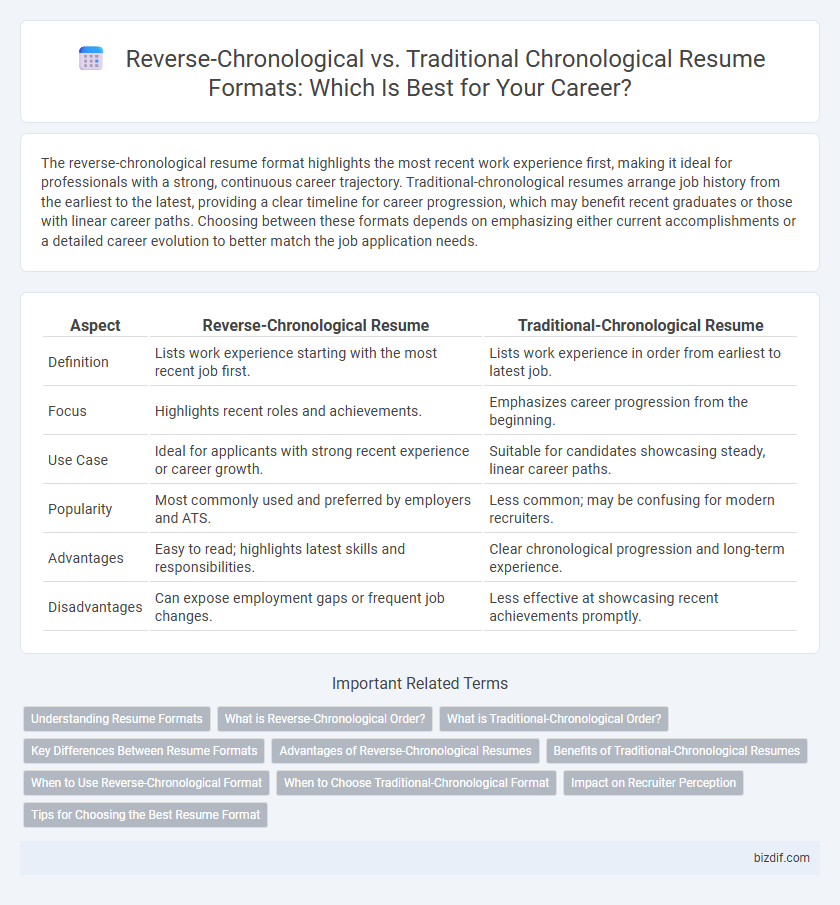The reverse-chronological resume format highlights the most recent work experience first, making it ideal for professionals with a strong, continuous career trajectory. Traditional-chronological resumes arrange job history from the earliest to the latest, providing a clear timeline for career progression, which may benefit recent graduates or those with linear career paths. Choosing between these formats depends on emphasizing either current accomplishments or a detailed career evolution to better match the job application needs.
Table of Comparison
| Aspect | Reverse-Chronological Resume | Traditional-Chronological Resume |
|---|---|---|
| Definition | Lists work experience starting with the most recent job first. | Lists work experience in order from earliest to latest job. |
| Focus | Highlights recent roles and achievements. | Emphasizes career progression from the beginning. |
| Use Case | Ideal for applicants with strong recent experience or career growth. | Suitable for candidates showcasing steady, linear career paths. |
| Popularity | Most commonly used and preferred by employers and ATS. | Less common; may be confusing for modern recruiters. |
| Advantages | Easy to read; highlights latest skills and responsibilities. | Clear chronological progression and long-term experience. |
| Disadvantages | Can expose employment gaps or frequent job changes. | Less effective at showcasing recent achievements promptly. |
Understanding Resume Formats
Reverse-chronological and traditional-chronological resume formats both organize work experience by listing the most recent jobs first, highlighting career progression and stability. Reverse-chronological resumes emphasize recent achievements, making them ideal for candidates with continuous work history in the same field. Understanding these formats helps job seekers choose the best structure to showcase relevant skills and experience effectively to potential employers.
What is Reverse-Chronological Order?
Reverse-chronological order in resume writing lists work experience starting with the most recent job and progressing backward to earlier positions, highlighting career progression and recent achievements. This format is preferred by employers because it clearly showcases current skills and professional development. It contrasts with traditional chronological order, which begins with the earliest job and moves forward, often making recent experience less prominent.
What is Traditional-Chronological Order?
Traditional-chronological order in resume writing organizes work experience starting from the earliest job to the most recent, highlighting steady career progression and long-term employment. This format is ideal for candidates with continuous employment history and clear advancement within a specific field. Employers often prefer this structure as it provides a straightforward timeline of a candidate's professional development.
Key Differences Between Resume Formats
Reverse-chronological resumes list work experience starting with the most recent position, emphasizing a clear career progression and making it easier for employers to see relevant job history. Traditional-chronological resumes present work experience in the order it occurred, which may highlight the length of tenure but can obscure recent achievements. Key differences include the presentation of timelines, focus on recent versus overall career, and suitability for professionals with consistent work history versus those with career gaps or changing industries.
Advantages of Reverse-Chronological Resumes
Reverse-chronological resumes highlight recent work experience first, making it easier for employers to see current skills and accomplishments quickly. This format emphasizes career progression and continuity, which is ideal for professionals with a strong, consistent work history. It also aligns with applicant tracking systems (ATS), enhancing the chances of passing initial automated screenings.
Benefits of Traditional-Chronological Resumes
Traditional-chronological resumes highlight a candidate's career progression by listing work experience in order from earliest to most recent, providing a clear timeline that employers find easy to follow. This format emphasizes consistent employment history and career growth, which is beneficial for applicants with steady work experience in a specific field. Hiring managers often prefer traditional-chronological resumes as they quickly assess qualifications and evaluate long-term commitment to roles.
When to Use Reverse-Chronological Format
The reverse-chronological resume format is ideal for candidates with a strong, consistent work history directly related to the desired job, as it highlights recent roles and career progression. This format allows employers to quickly assess relevant experience and accomplishments, making it perfect for professionals seeking to advance within their industry. Job seekers transitioning to a similar position benefit from emphasizing up-to-date skills and responsibilities in this resume style.
When to Choose Traditional-Chronological Format
The traditional-chronological resume format is ideal for professionals with a consistent work history and clear career progression, highlighting steady growth within a specific industry. Employers prefer this format because it showcases job titles, employers, and dates in a straightforward sequence, making it easier to assess experience and reliability. Candidates re-entering the workforce or seeking roles in established fields benefit most from this resume style, as it emphasizes stability and long-term commitment.
Impact on Recruiter Perception
Reverse-chronological resumes highlight the most recent and relevant experience first, enabling recruiters to quickly assess current skills and career progression, which often results in a favorable initial impression. Traditional-chronological resumes present experience in the order it occurred, potentially causing recruiters to spend more time evaluating the candidate's growth and relevance to the role. The choice between these formats significantly impacts recruiter perception by either emphasizing recent achievements or providing a comprehensive career timeline.
Tips for Choosing the Best Resume Format
Selecting the right resume format hinges on your career trajectory and job target; reverse-chronological resumes emphasize recent roles, ideal for professionals with a strong, continuous work history. Traditional chronological resumes list experiences in sequential order, providing a clear timeline that benefits candidates with steady career progression. Tailor your choice by assessing job requirements, highlighting relevant skills, and ensuring the format showcases your achievements most effectively to applicant tracking systems (ATS) and hiring managers.
Reverse-chronological vs Traditional-chronological Infographic

 bizdif.com
bizdif.com